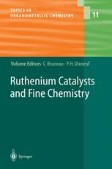Search
Search Results
-
Ruthenium-Promoted Radical Processes Toward Fine Chemistry
Ruthenium holds a prominent position among the many transition metals used in radical chemistry. The dichlorotris(triphenylphosphine) complex...
-
Cyclopropanation with Ruthenium Catalysts
In this decade, a variety of ruthenium complexes have been intensively investigated that exhibit catalytic activity for cyclopropanation of olefins...
-
Metal Carbene Reactions from Dirhodium(II) Catalysts
The dirhodium(II) core is a template onto which both achiral and chiral ligands are placed so that four exist in a paddle wheel fashion around the...
-
Chromium-Templated Benzannulation Reactions
Since its discovery the chromium-mediated benzannulation reaction has been developed into a unique and useful tool in organic synthesis. In this...
-
Photoinduced Reactions of Metal Carbenes in Organic Synthesis
The photoinduced reactions of metal carbene complexes, particularly Group 6 Fischer carbenes, are comprehensively presented in this chapter with a...
-
Chiral Diaminocarbene Complexes, Synthesis and Application in Asymmetric Catalysis
The synthetic routes to optically pure N-heterocyclic carbene (NHC) complexes and their application in asymmetric catalysis is reviewed. Chiral...
-
Non-covalent Immobilization of Catalysts Based on Chiral Diazaligands
The immobilization of chiral catalysts through non-covalent methods, as opposed to covalent immobilization, allows an easier preparation of chiral...
-
Biological Organometallic Chemistry of B12
Vitamin B12, the “antipernicious anemia factor” required for human and animal metabolism, was discovered in the late 1940s. B12-derivatives are...
-
Medicinal Properties of Organometallic Compounds
Although organometallic compounds are ubiquitous in nature, synthetic organometallic compounds are generally considered to be toxic or...
-
Directed Synthesis of Biologically Interesting Heterocycles with Squaric Acid (3,4-Dihydroxy-3-cyclobutene-1,2-dione) Based Technology
A variety of methods for organic transformation starting from squaric acid have been developed in this decade. These are based on conversion of...
-
Microwave-Assisted Multicomponent Reactionsfor the Synthesis of Heterocycles
Multicomponent reactions offer convenient procedures for the introduction of many points of structural diversity into heterocyclic compounds...
-
Diazo and Diazonium DNA Cleavage Agents: Studies on Model Systems and Natural Product Mechanisms of Action
Diazonium salts have been previously used to cleave DNA via generation of carbon centered radicals and cations. Efforts have been made in the...
-
Quinazoline Alkaloids and Related Chemistry
Recent progress in quinazoline alkaloids and related chemistry was reviewed focusing on developments of the synthetic methodologies and their...
-
Transition-Metal-Based Carbon–Carbon and Carbon–Heteroatom Bond Formation for the Synthesis and Decoration of Heterocycles
A literature overview, up to the end of 2004, of the most important microwave-assisted transition-metal-mediated processes used for the decoration...
-
Predicting Pharmacological and Toxicological Activity of Heterocyclic Compounds Using QSAR and Molecular Modeling
Heterocyclic compounds are important as drugs, toxicants, and agrochemicals. In this review, we report the QSAR modeling of pharmacological...
-
Synthesis of Biologically Active Heterocyclic Stilbene and Chalcone Analogs of Combretastatin
Combretastatin A-4 (CA-4, 7) has had a major impact in the field of medicinal chemistry as a potent bioactive molecule that binds to the...
-
Synthesis of Heterocycles via Microwave-Assisted Cycloadditions and Cyclocondensations
Controlled microwave heating has found many important applications in the synthesis of heterocycles. Almost all kinds of heterocycles have been...
-
Overcoming Bacterial Resistance: Role of β-Lactamase Inhibitors
Resistance to modern antibiotics is currently a major health concern in treating infectious diseases. Abuse, overuse, and misuse of antibiotics in...
-
Bioactive Heterocyclic Alkaloids of Marine Origin
Many kinds of alkaloids with extraordinary structures and significant biological activities have been isolated from marine organisms. This work...
-
Synthesis of Carbolines Possessing Antitumor Activity
Synthetic approaches to a number of carboline derivatives having antitumor activity are described. Representative examples of molecules with...
